1lumen selects and reviews products personally. We may earn affiliate commissions through our links, which help support our testing.
Olight Seeker 3 review
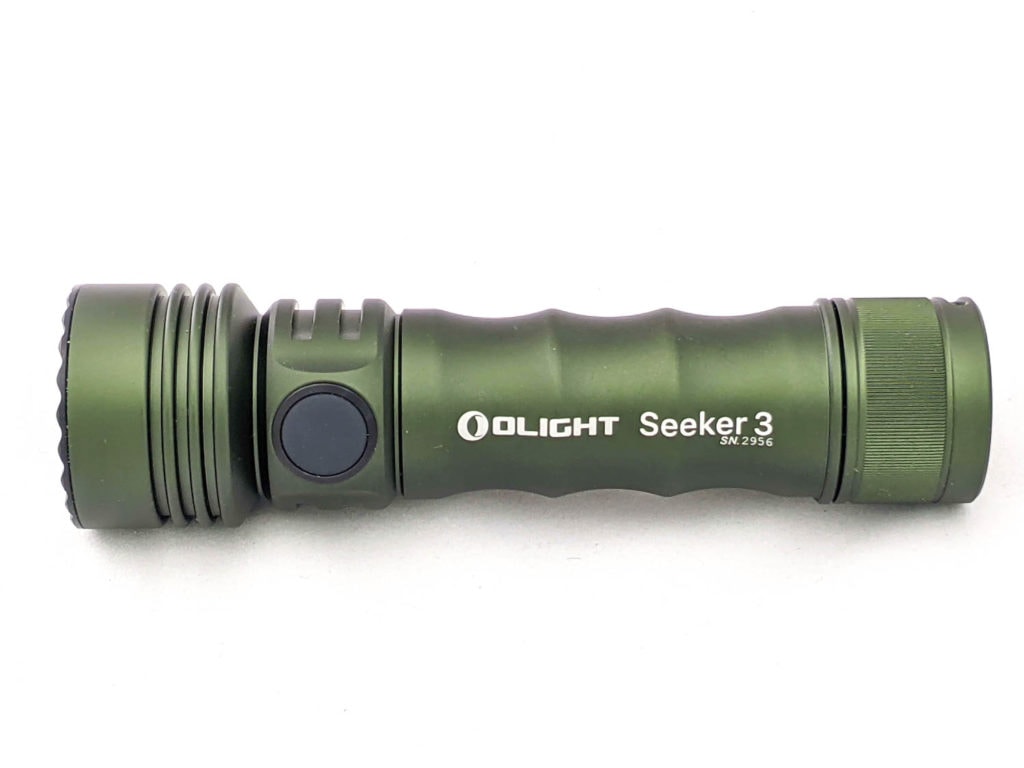
Olight Seeker 3 specifications
| Brand/model | Olight Seeker 3 |
|---|---|
| Category | Best EDC flashlights |
| LED | ? |
| Lumens | 3,500 lm |
| Beam intensity | 12,100 cd / 220m |
| Battery config. | 1*21700 (proprietary) |
| Material | Aluminum |
| Modes | 5 |
| Blinkies | Strobe |
| Reflector | TIR optics |
| Waterproof | IPX8 |
| Review date | November 2021 |
Introduction:
Brand’s history,
My first Olight! Will I love it or hate it?
Olight is a bit like the Apple of the flashlight world: premium quality, innovative industrial design and using their own standards. I’m not an Apple fanboy but I’ve come to appreciate their products, even if it means having to do things the Apple way. So how will I react to my first proper Olight (aside from the tiny i1R 2 keychain light)?
This is the 3rd generation of Seeker flashlights, which are their high power EDC range. I actually remember when Olight released their Olight R50 Pro Seeker about 5 years ago, thinking that 3200 lumens from a single cell light sounded incredible. Over the years Olight have released many lights with the Seeker name; most recently this Seeker 3 and the slightly more powerful Seeker 3 Pro.
The Seeker 2 that this is a direct upgrade from has 3 Osram LEDs that produce 3000 lumens, so the 3 gives you a 17% boost to 3500. It also comes with a few other upgrades – read on for more.
Package quality.
My expectations were high due to what I’ve heard about Olight. As I opened the shipping parcel I could see a neatly shrink-wrapped box. Even from the start, this is a slight step up from high-end lights from Acebeam or Imalent.
The box states the Seeker 3 is a limited edition. I think that’s referring to the OD Green (olive drab) edition. They also come in black.
Opening the box, you realise that it really is like an Apple product. Simple messages are revealed as you progressively remove items from the box.
OK, I’m impressed so far. But this is a flashlight review, not a box review, so Olight isn’t guaranteed a 5 star rating just yet…
- Olight Seeker 3 flashlight
- Olight 21700 battery (4000mAh, proprietary)
- MCC3 magnetic charging cable
- Manual
- Charging guide
Compared to the Pro version, the cell is 4000mAh instead of 5000mAh and there’s no holster. Unfortunately there’s no pocket clip, as with all the Seeker range.
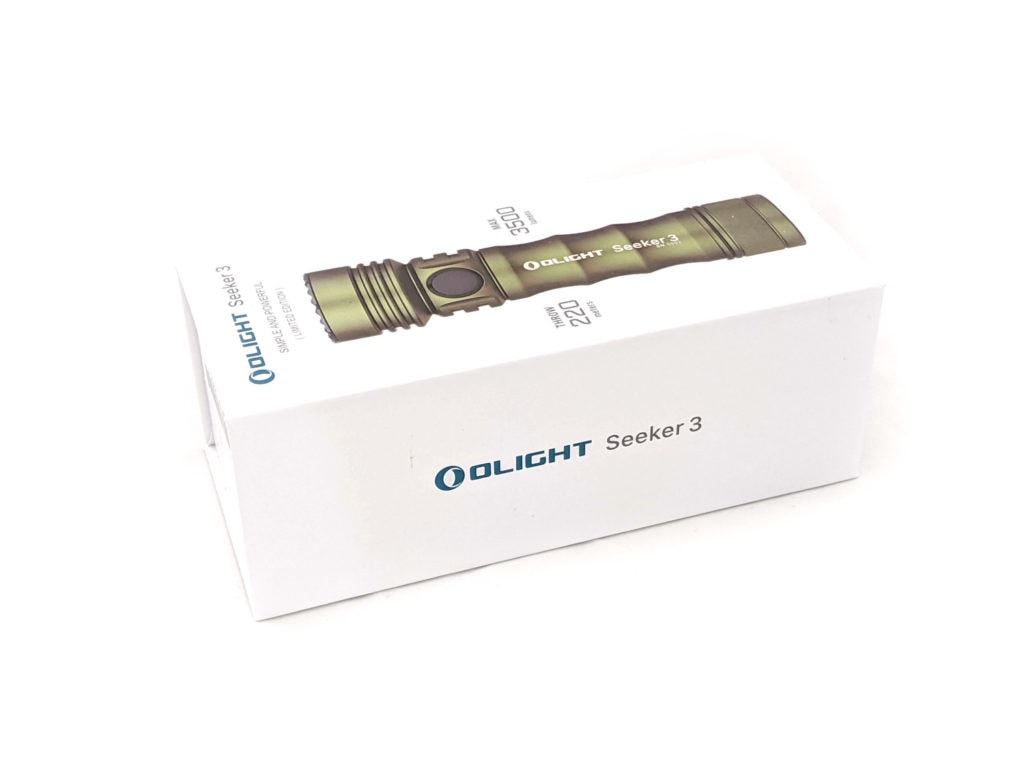
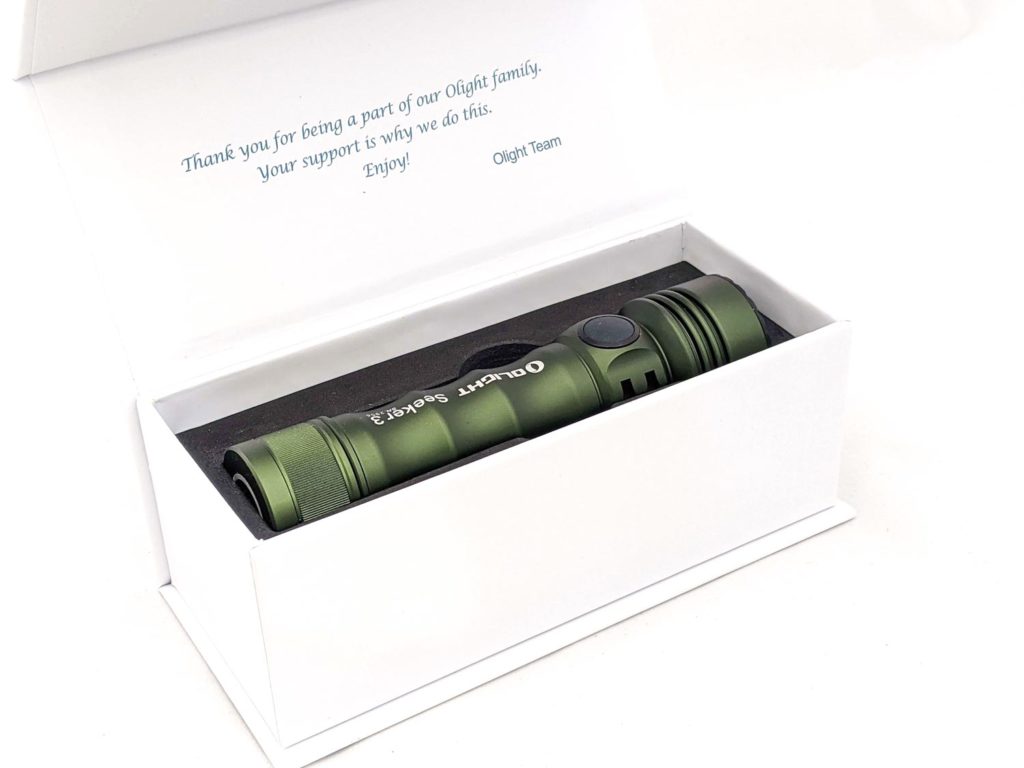
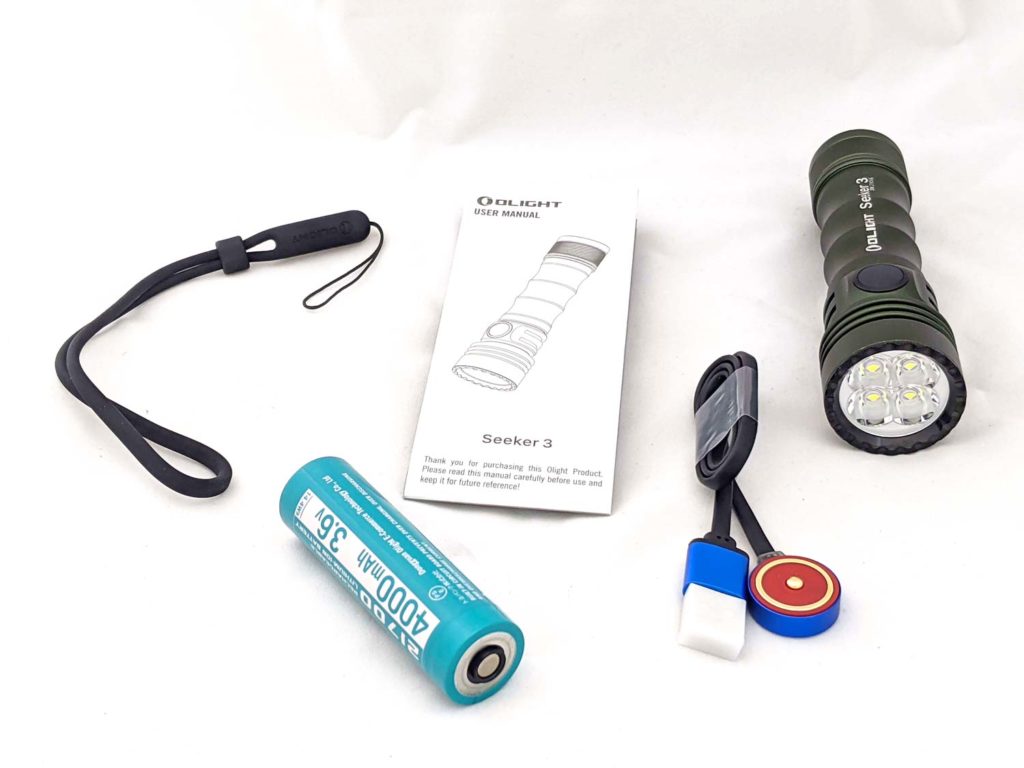
Flashlight in use
There’s no knurling here but instead there’s comfortable “bamboo” style bumps. These make the moderately slippery surface easy to grip.
On to the switch. It’s so smooth! The switch is easy to find in the dark due to being on a raised part of the head. It makes a nice quiet click and is noticeably higher quality than you get from a budget manufacturer. Even though it’s raised, it doesn’t stop the Seeker 3 from rolling. In fact the Seeker 3 is one of my most rolly flashlights.
All of the Seeker range is fairly big for EDC lights but very easy to hold. It’s fairly slim for a 21700 light so will fit in your pocket with no issues if you’re used to carrying 21700 flashlights and might not be much of a step up from 18650 ones.
Olight provides a lanyard for the light too. The lanyard isn’t quite like a normal one: it appears to be a silicon-coated material, similar to thick headphone cables – very fancy. The lanyard attaches through the tail cap and doesn’t interfere with tail standing or the magnetic charging.
But there’s no clip. The Pro version comes with a holster but the non-Pro doesn’t, so it’ll have to live in a pocket, maybe alongside other items that will scratch the smooth anodising. You can actually buy a clip for the Seeker 2 – there’s a chance that will fit the 3 too.
The tailcap is magnetic, which is used by the new MCC3 charger. The magnet also allows the Seeker 3 to attach to ferrous surfaces and manages to hold its own weight horizontally on my filing cabinet.
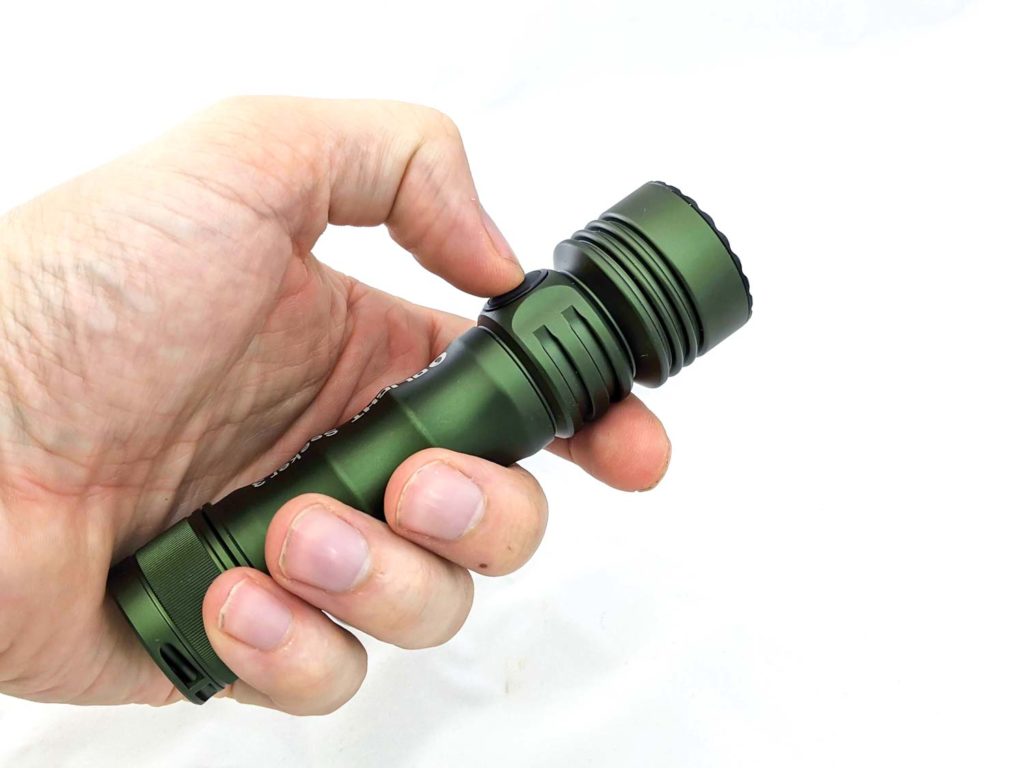
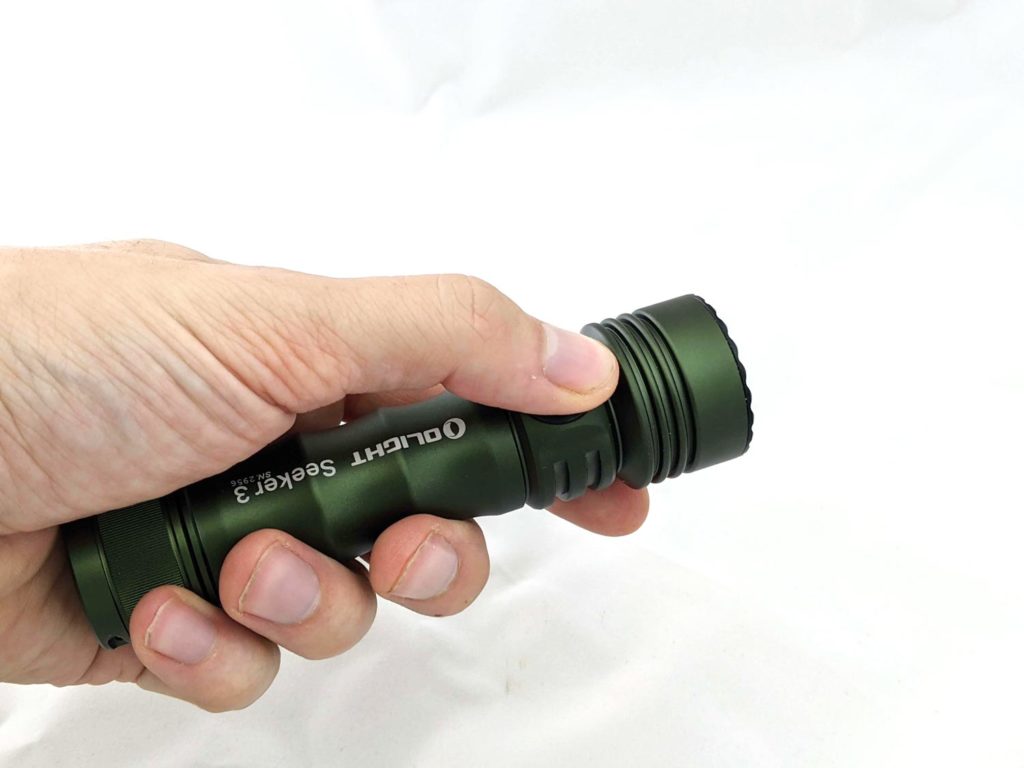
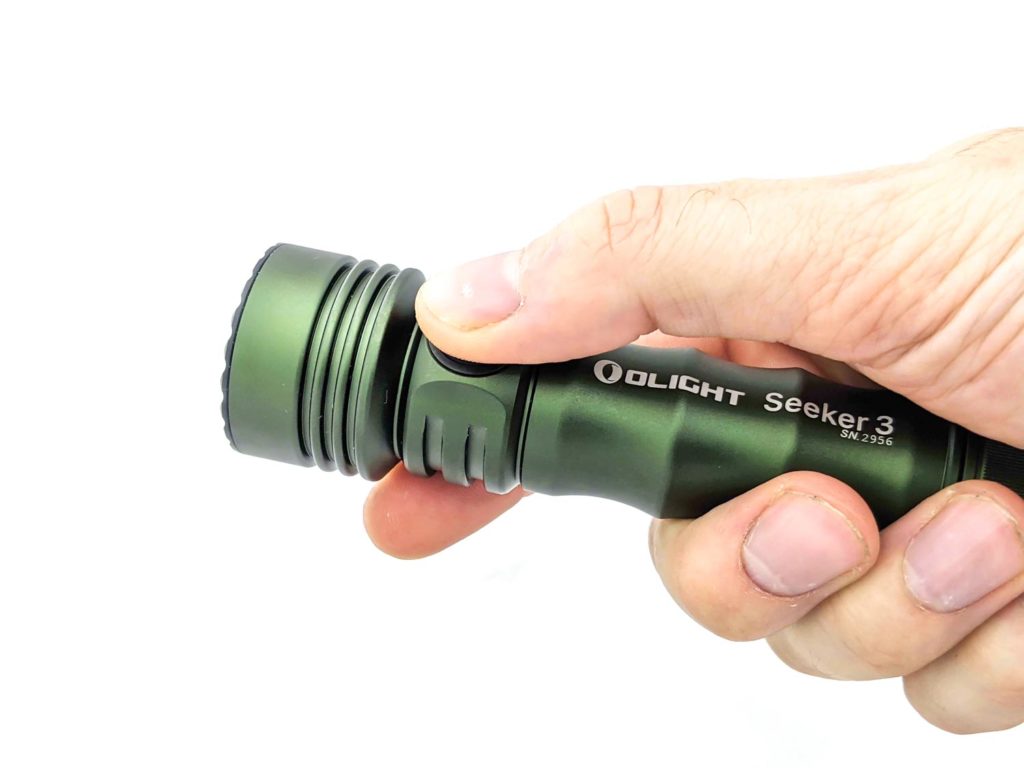
Build Quality, and Warranty
The Seeker 3 lives up to the Olight hype. Very smooth anodising on the aluminum with a slight sheen. The threads are square cut and buttery smooth with sufficient lube. All the edges are chamfered and aside from the bezel crenelations there’s not a sharp part of the light.
Opening up the light to get to the driver… wait… Olight don’t let you take the Seeker 3 apart. Only the tail cap comes off and the rest of the light is 1 part. I couldn’t unscrew the bezel either, though I’m sure a persistent modder could gain access to the LEDs.
Olight warranty:
If your Olight product has any defect as the result of the materials or workmanship we want to make it right! Within 30 days of purchase: Return the product to the retailer you purchased it from and they will replace or repair it. Period. Within 5 years of purchase: Return the product to Olight and we will repair or replace it as long as the light is not working because of factory defects. This does not include obvious user wear or extreme damage. After 5 years of purchase: Return the product to Olight and we will repair or replace it. We will assess the fees involved and will let you know once we receive it.
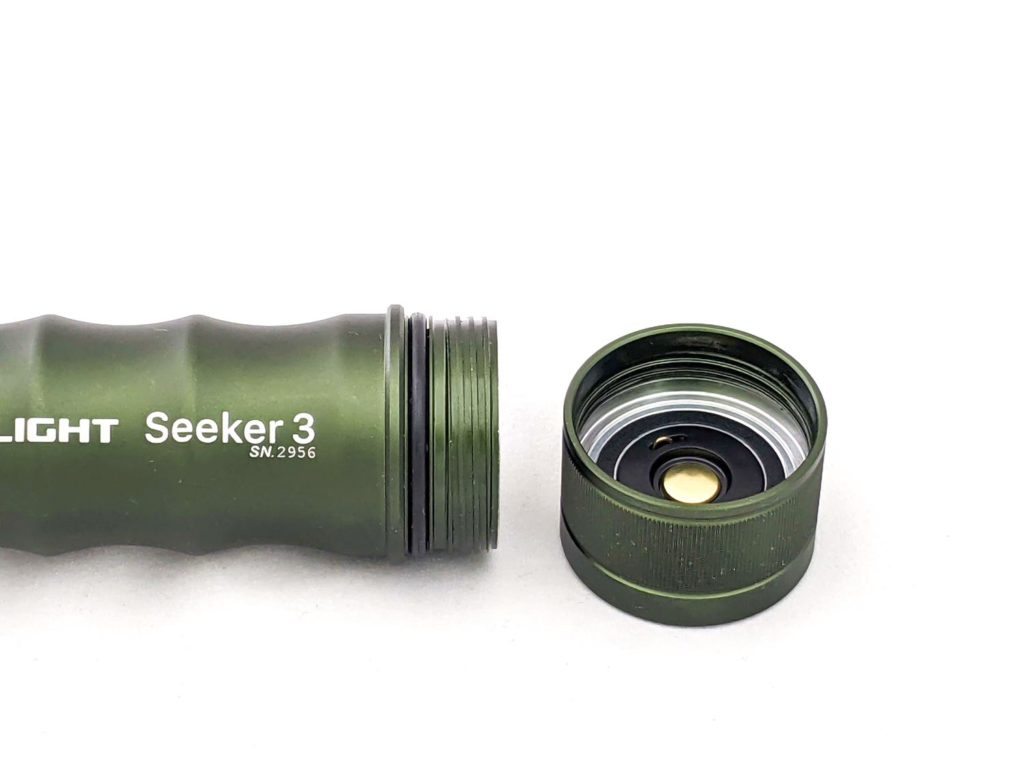
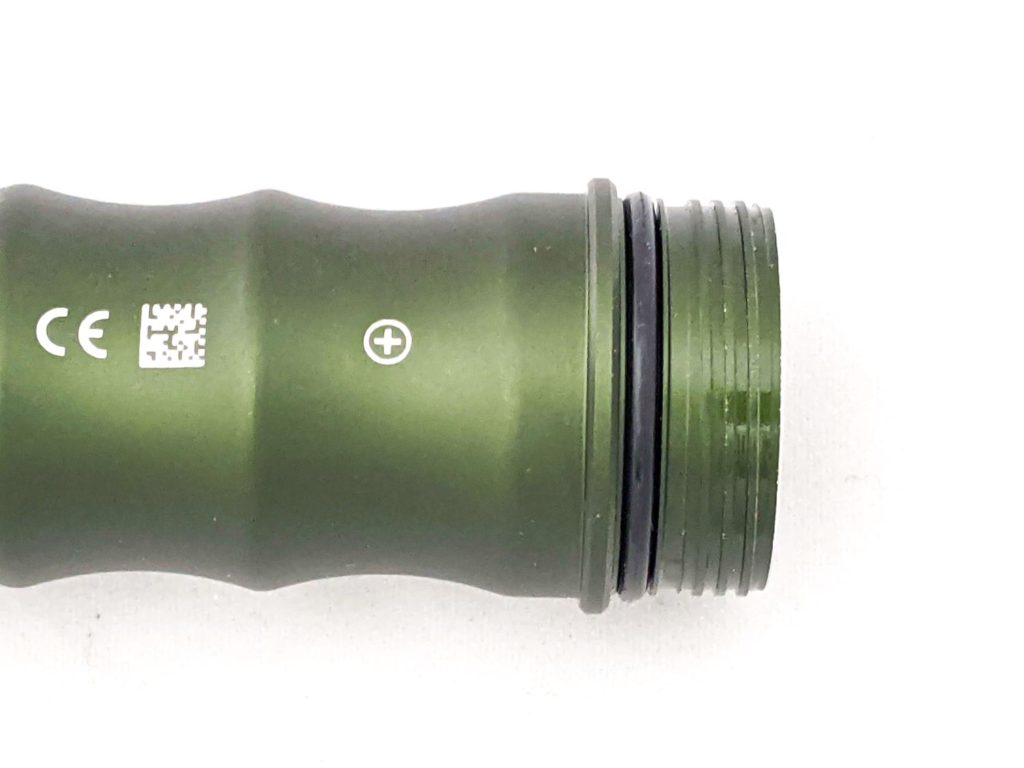
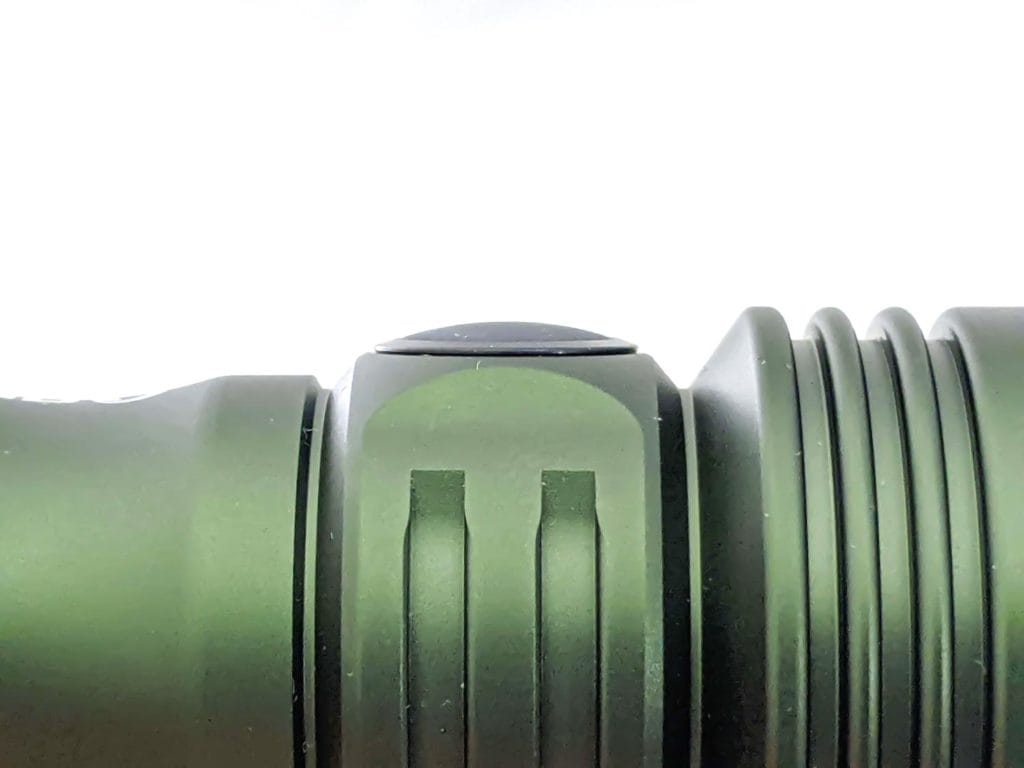
LED, Lens, Bezel, and Reflector
Olight have upgraded the Seeker 3 to use 4 LEDs behind TIR optics instead of just 3 from the Seeker 2. These TIRs don’t look like standard Carlco quads and are bigger than the TIRs in my D4V2. They’re slightly smaller than the TIRs in the D4SV2 and are merged together, similar to what you see in quad reflector flashlights like the Sofirn Q8.
Behind the TIR are 4 cool white LEDs. Olight doesn’t name them at all. The Seeker 2 came with Osram LEDs but an unknown model. I’m not even sure who manufactures the Seeker 3’s LEDs. All I can tell is that they’re domed and look like 3535 size. This is annoying, as the spreadsheet of all my flashlights and their specs is now missing a value as I don’t know anything about the LEDs.
Fortunately I have one of these Opple Light Master 3 devices, which gives a good indication of the output (but isn’t a laboratory device):
- CRI (Ra): 64.6 (low)
- CCT 5444 (slightly cool)
- Duv: 0.0126 (above BBL)
These numbers are very close to Marco’s on his Seeker 3 Pro review, so I expect they’re the same LED.
Olight has definitely picked the LED for lumens, rather than colour quality. That’s understandable but with the number of different product options for anodising colours they have on some of their lights, I’d have liked to see a few LED colour temperature options too.
The 3500 lumens and 12,100 candela results in a very floody 3.5 cd/lm. This is a wall of light, rather than a long distance thrower.
Unlike the Pro, the standard Seeker 3 doesn’t have a proximity sensor.
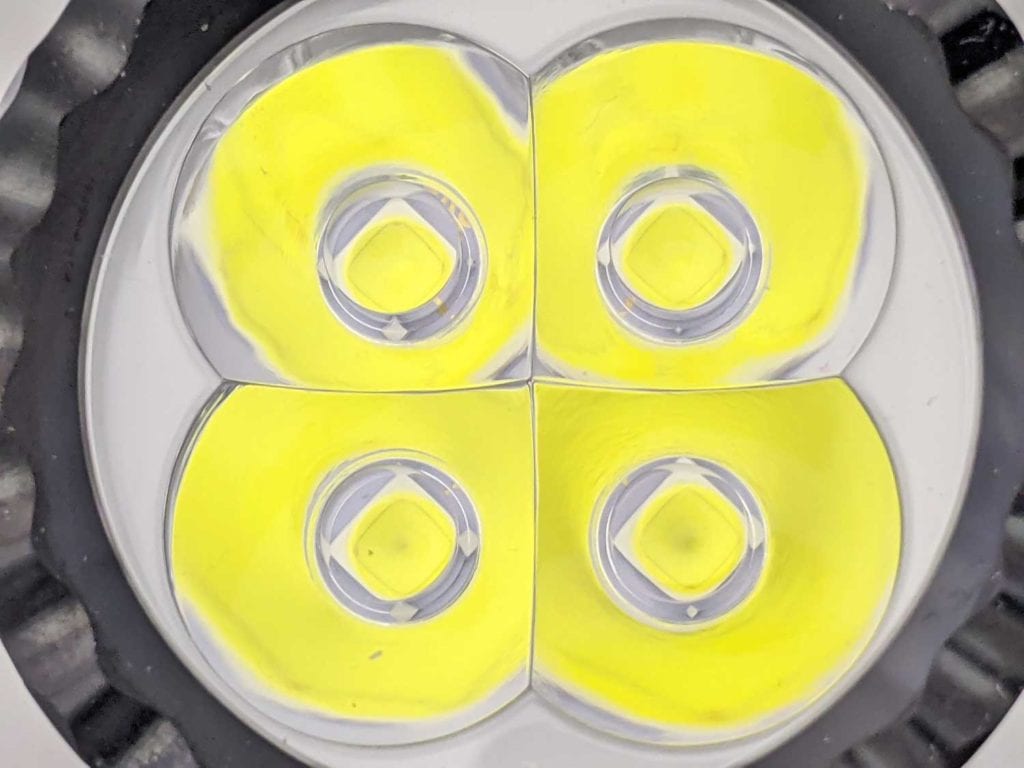
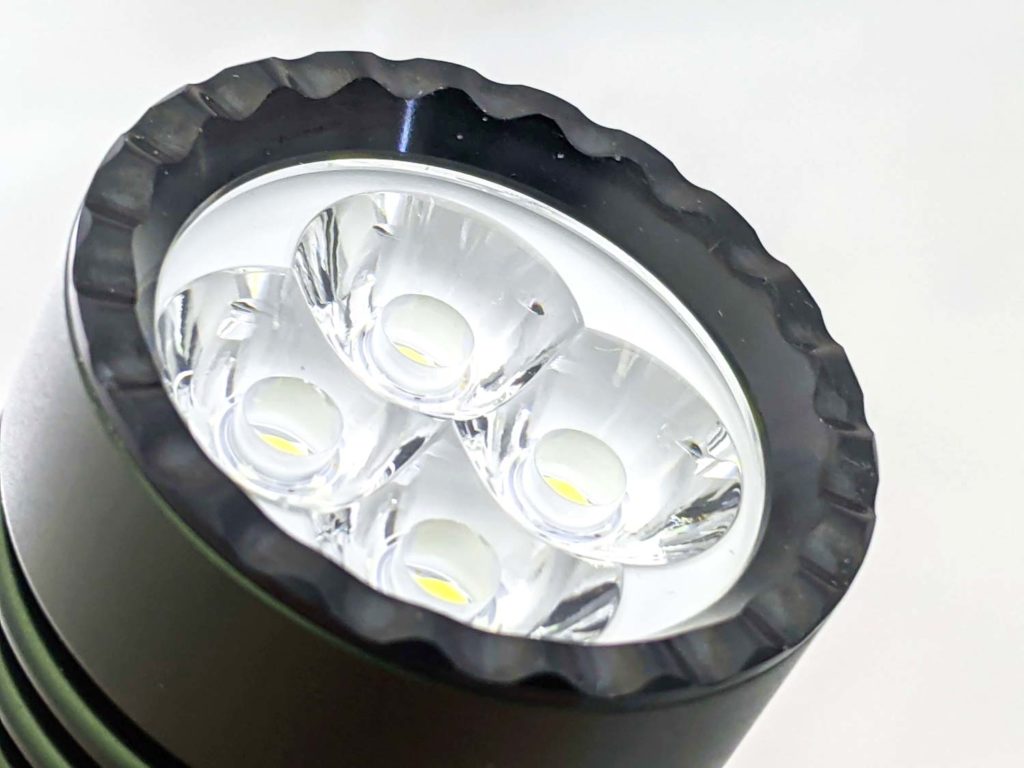
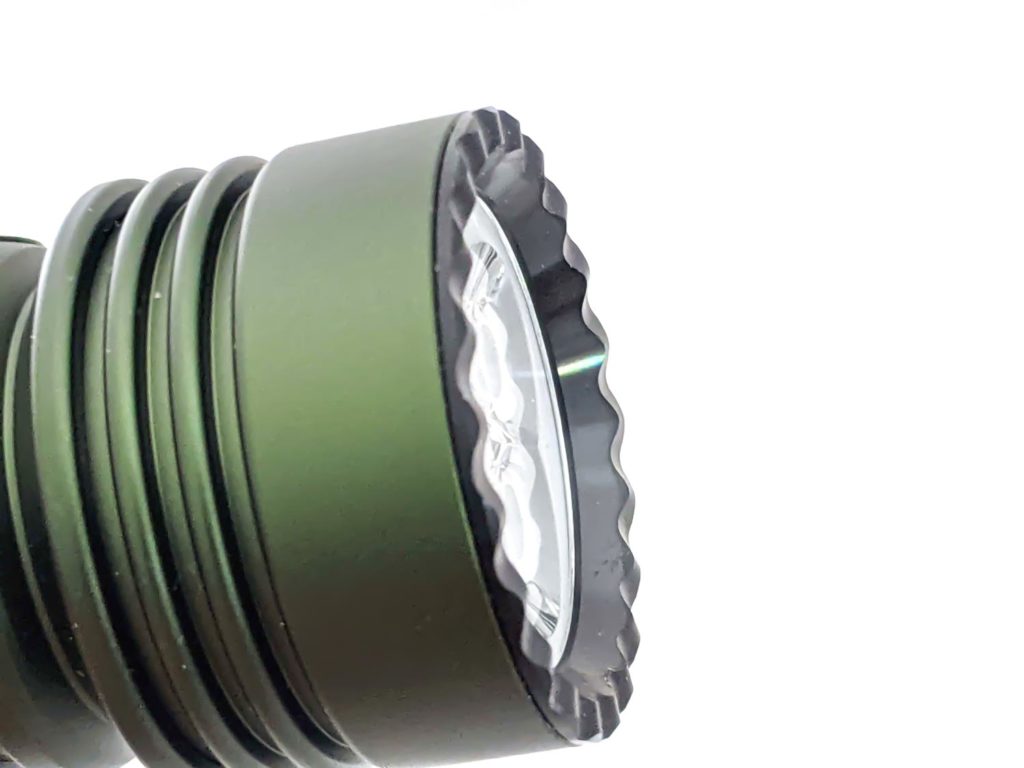
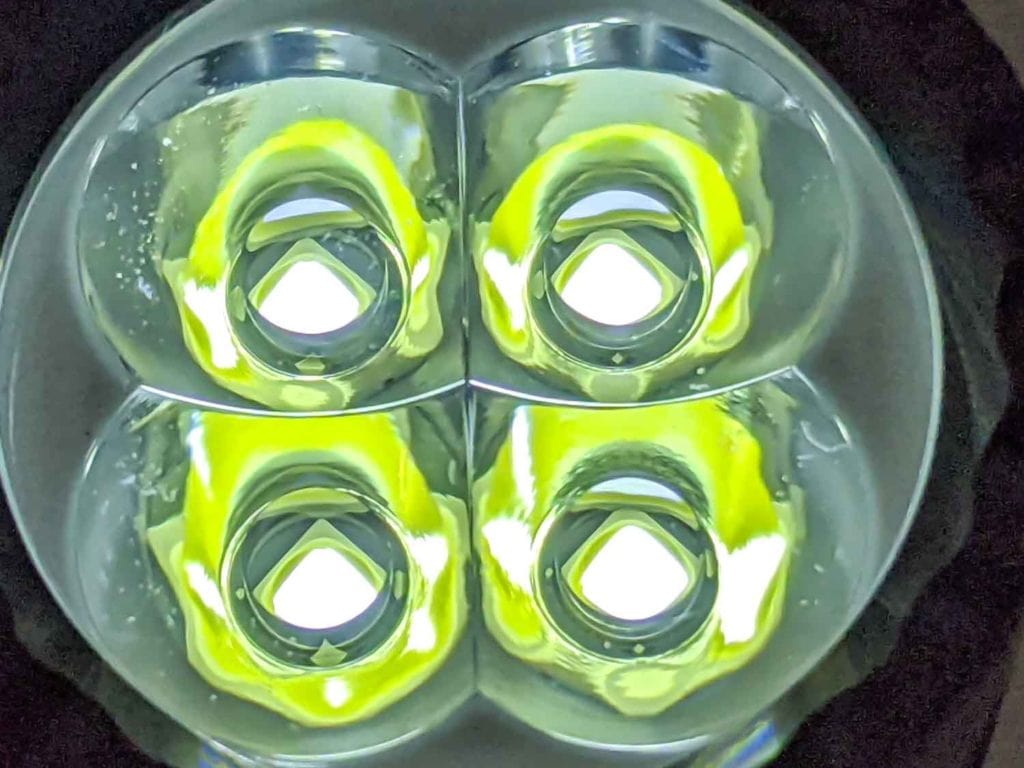
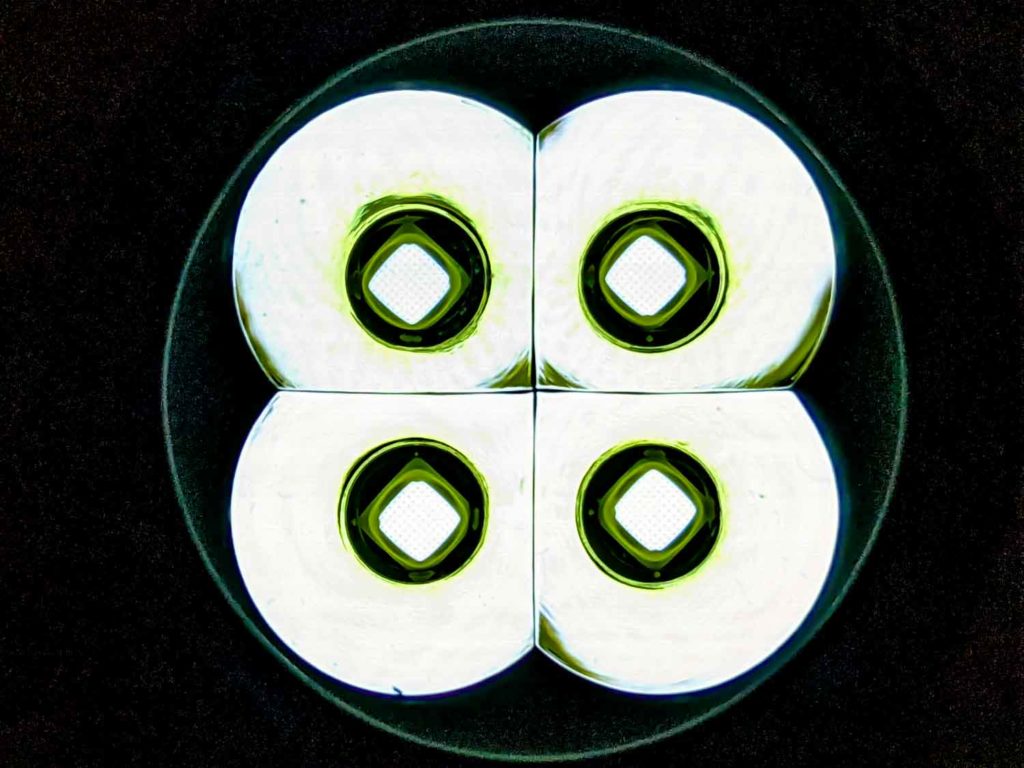
Dimensions and size comparison
- Length: 12.80 cm / 5.04 inches
- Head diameter: 3.48 cm / 1.37 inches
- Body diameter: 2.49 cm / 0.98 inches (minimum)
Weight:
- Without cells: 112g / 4.0oz
- With cells: 185g / 6.5oz
EDC Flashlight comparison
High power EDC lights from left to right::
- Emisar D4V2
- Emisar D4SV2
- Manker MC13 90.2
- Sofirn SD05
- Olight Seeker 3
- Cyansky P25
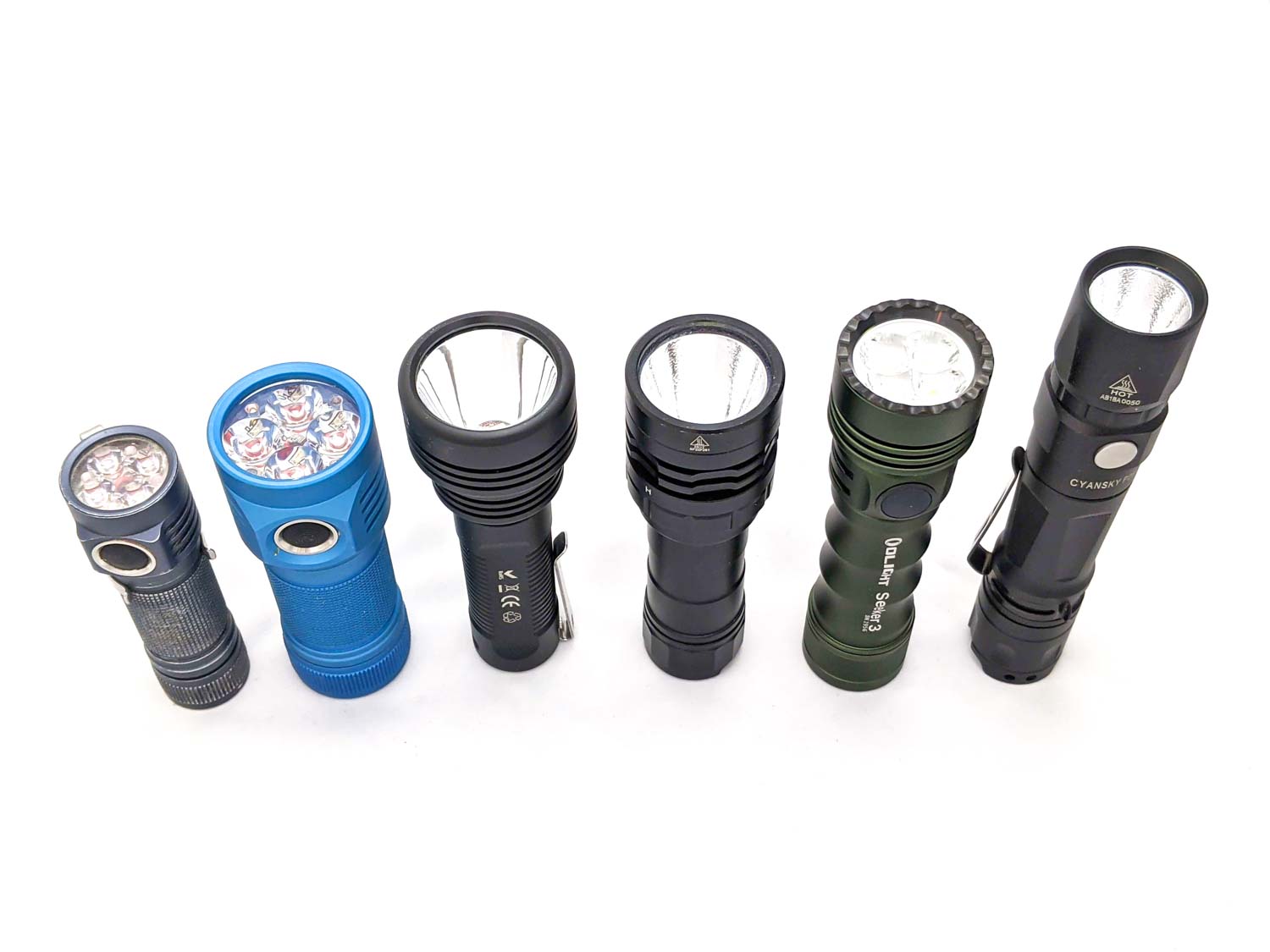
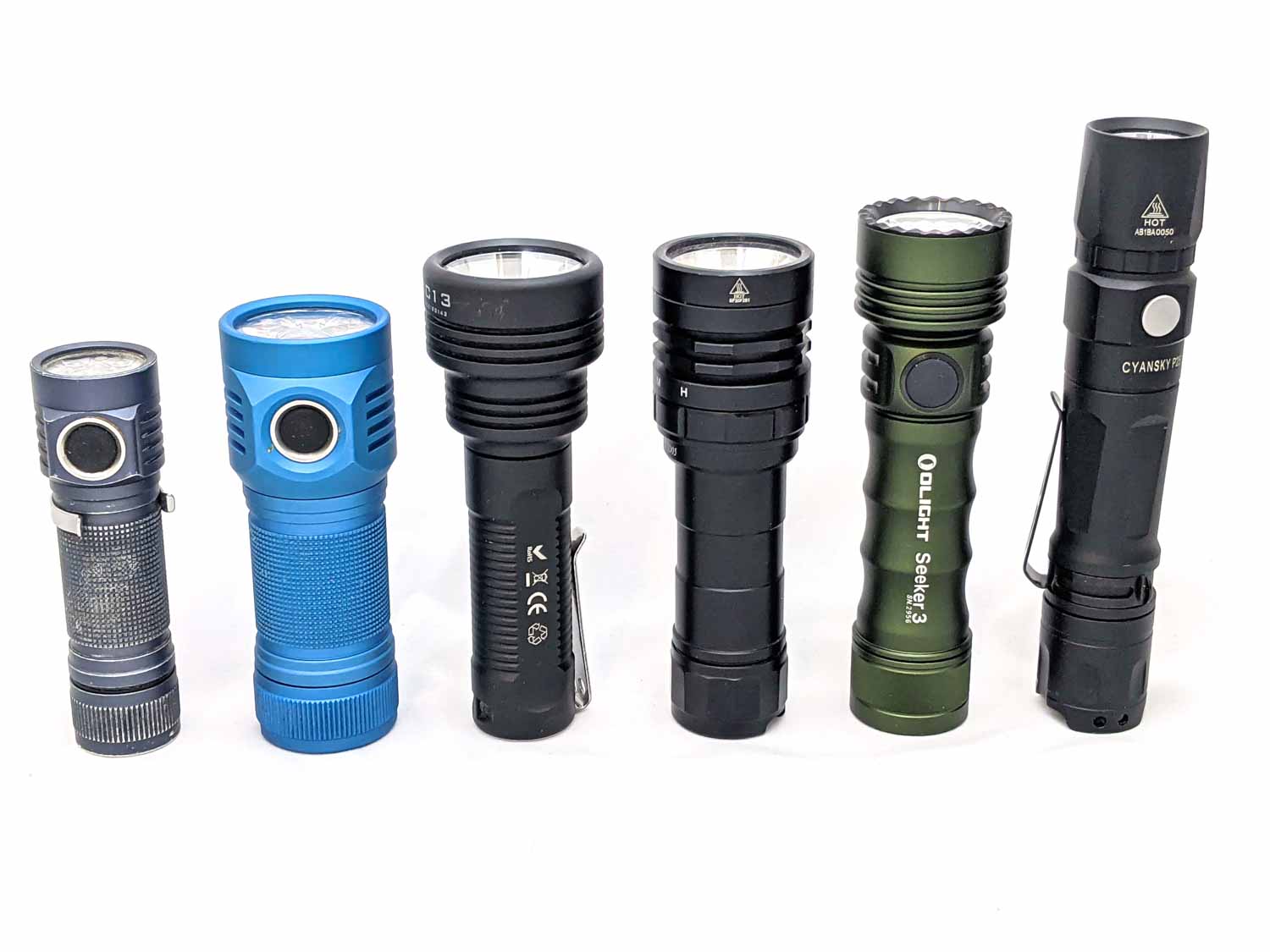
Driver & User Interface:
Click on, click off, hold to change brightness. That’s the basics covered.
Available modes: Moon, Low, Medium, Tigh, Turbo
From OFF:
- Hold: Moon
- Hold over 2s: Lockout
- Single click: Last used memory (except turbo)
- Double click: Turbo
- Triple click: Strobe
From ON:
- Press and Hold: Cycle; Low, Medium, High
- Single click: Turn off
- Double click: Turbo
- Triple click: Strobe
Mode memory:
- Moon, low, medium: normal mode memory
- High: mode memory for a minute, then medium mode will be memorised instead
- Turbo: high mode is memorised instead
Shortcuts:
- To Moon: Hold from off
- To Turbo: Double click
- To Strobe: Triple click
Low voltage warning:
- Yes, indicator on switch shows:
- Green for over 60%
- Orange for 10-60%
- Red for 5-10%
- Flashing red for 0-5%
Lock-out mode:
- Hold for 2 seconds to lock / unlock. Always turns on Moon after unlocking
PWM
- None detected
Timer mode:
- When on any mode, click, let go then hold (2H in Anduril terminology) to activate a 3 minute timer
- Click, let go then hold again to switch to a 9 minute timer
Batteries & Charging
Warning: the cell goes in backwards! Years of conditioning myself to put the battery in with the + end towards the head is now over.
Wars are fought over batteries in the flashlight world. Even more controversial than whether button tops or flat tops are best in a soda can flashlight is the practice of using customised cells. Olight is central to this fight, being well known for their proprietary customized cells.
The one that comes with the Seeker 3 is the Olight ORB-217C40A. This is a 4000mAh cell, so a little less than the one you get with the Seeker 3 Pro. At 75.2mm it doesn’t fit in any of my standard chargers.
The benefit of the proprietary cell is easy and safe magnetic charging on the tail cap. This is really handy and I can imagine it being used every day if you work nights, placing the Seeker on the charger as soon as you come inside.
It’s not all good news though. Get your pitchforks ready: the special cell is expensive to replace if you want a spare and you can’t use any normal 21700 cell.
Olight provides their newer MCC3 magnetic USB charger with the light. This is rated at 2A, which Olight says will complete in 3.5 hours. I got just over 1.5A from it at 5V, which should get about 2A to the cell at 3.7V. The MCC3 has a red indicator light when charging, which turns green when full.
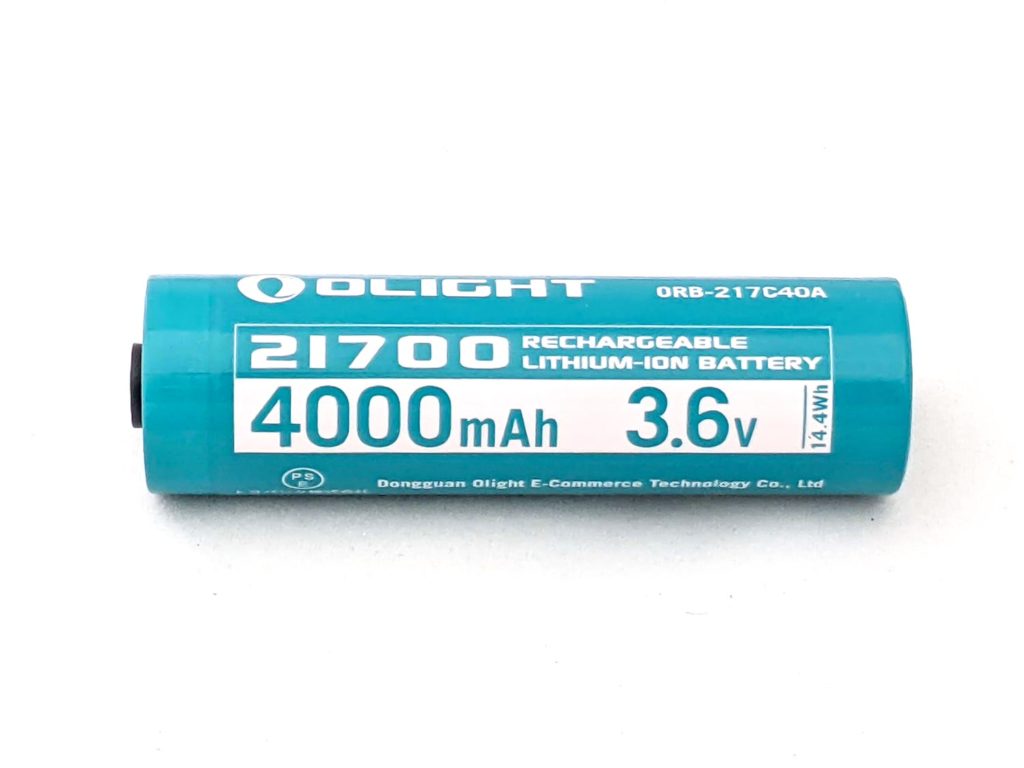
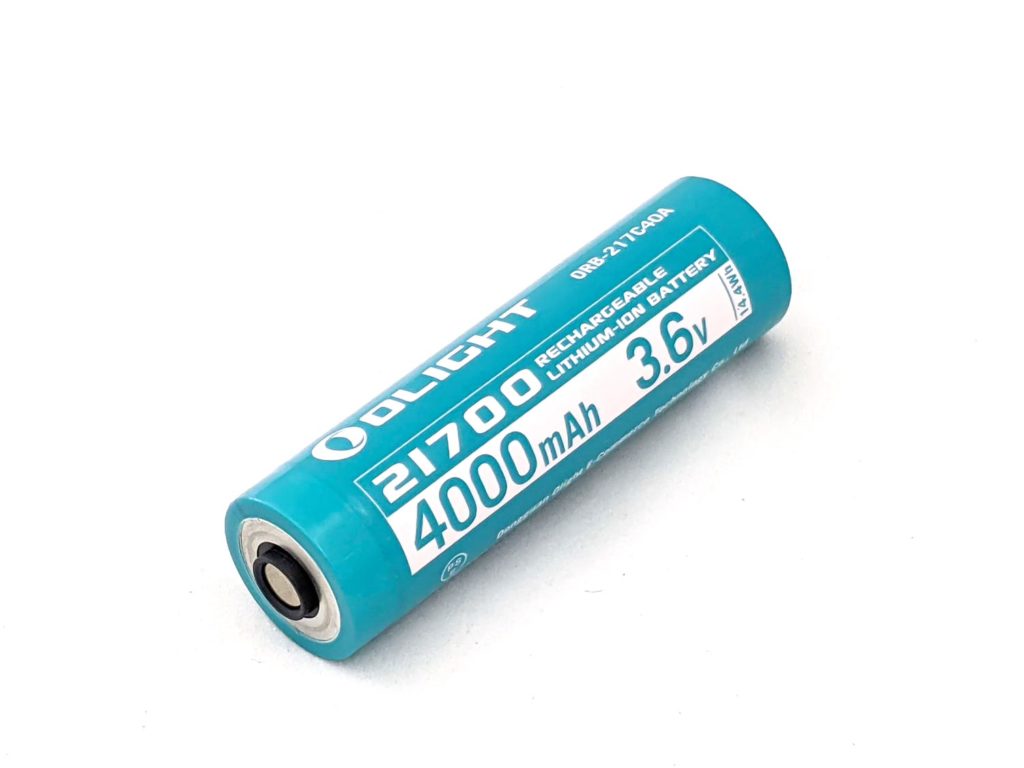
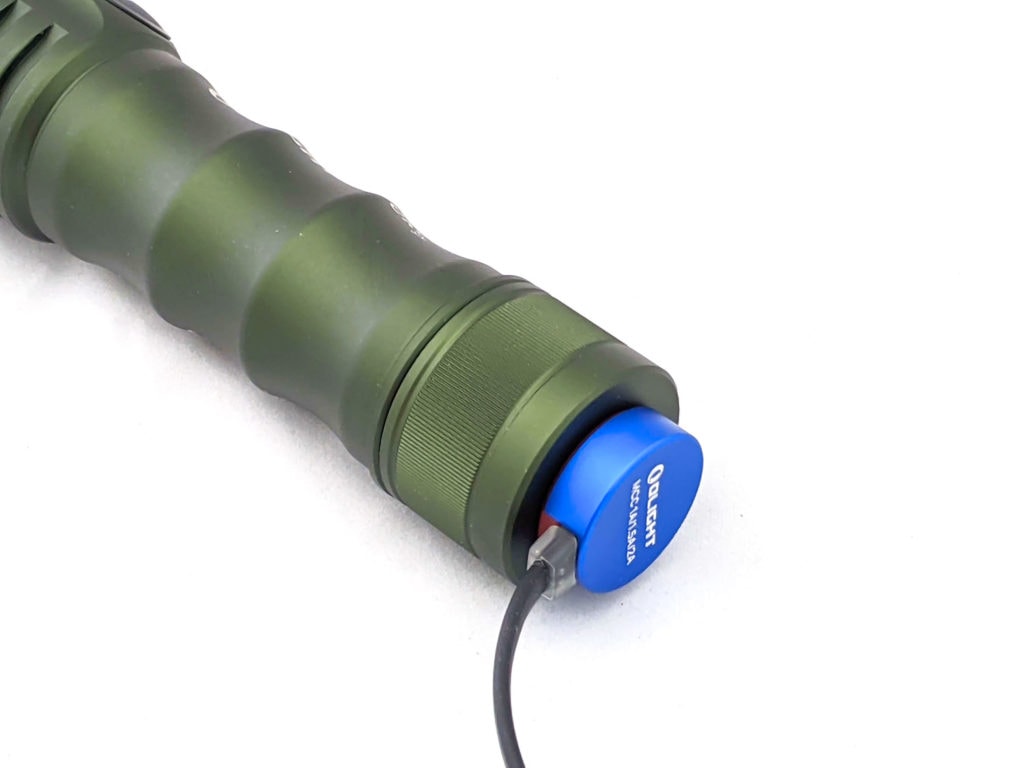
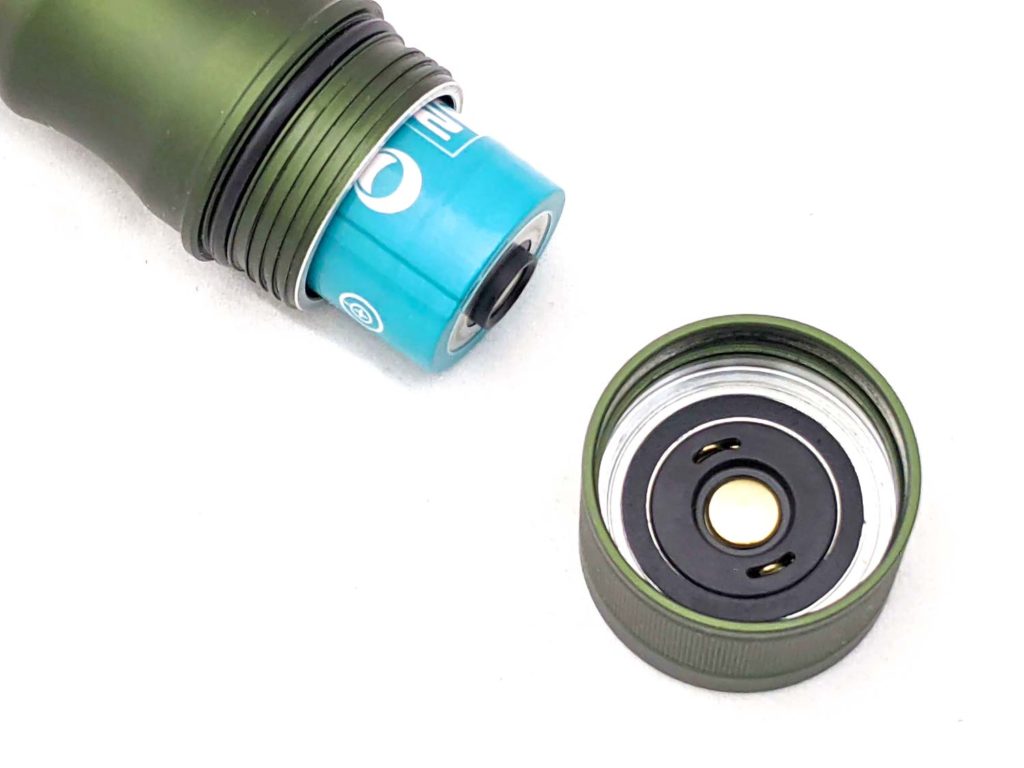
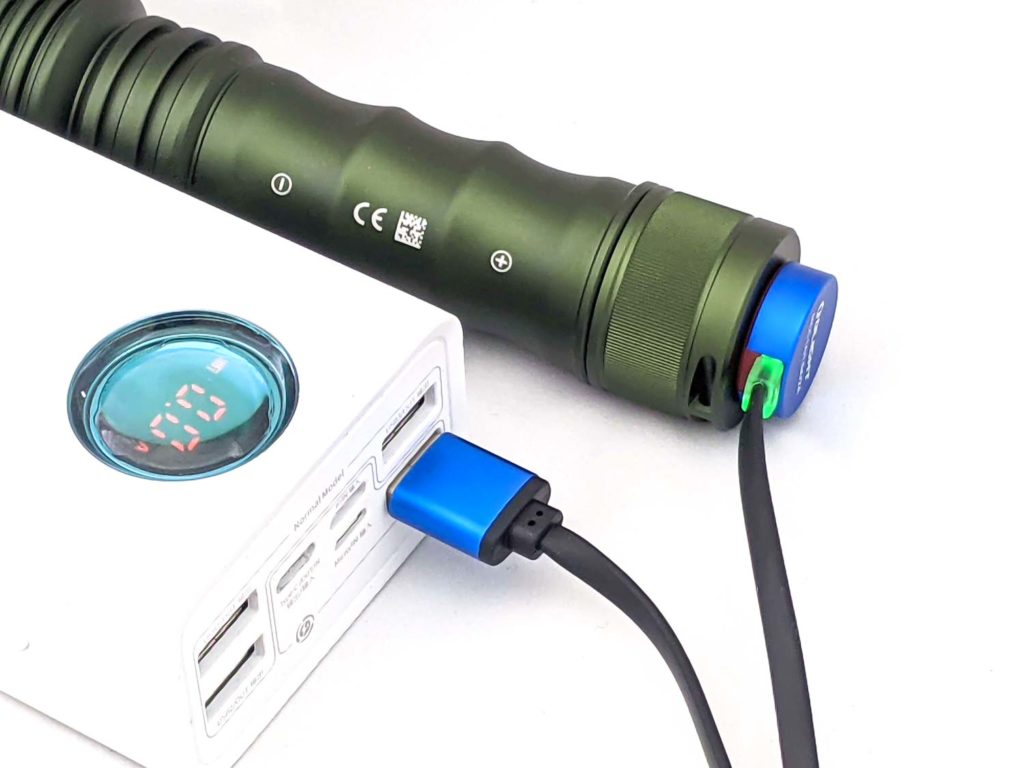
Performance
Lumen measurements:
Lux meter: All lux and lumen measurements are from my home made integrating sphere, calibrated with a S2+ measured by Maukka. Measurements are done with a UNI-T UT383S lux meter and Adafruit TSL2591 connected to a Raspberry Pi (using RuTiTe by bmengineer). Expect them to be within +/-10%.
I used Olight’s provided 4000mAh cell, charged to 4.18V.
| Mode | Specs | start | 30 sec | 10min |
|---|---|---|---|---|
| Moon | 5 | 6 | 6 | – |
| Low | 50 | 49 | 49 | – |
| Med | 300 | 283 | 283 | 283 |
| High | 1200 | 1155 | 1155 | 1145 |
| Turbo | 3500 | 3275 lm | 3261 lm | 1111 lm |
Aside from turbo, these were all within a couple of percent of both the specs and Marco’s numbers for the Seeker 3 Pro. Perhaps my amateur integrating sphere is more accurate than I first thought.
Runtime graph
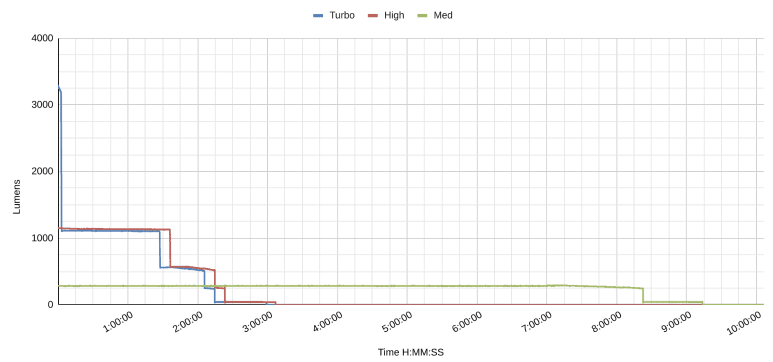
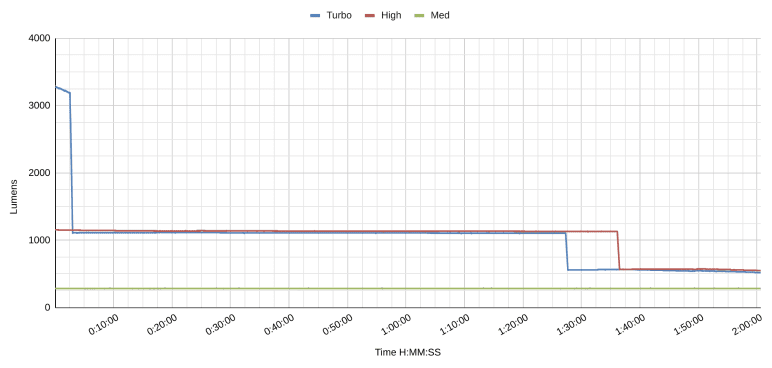
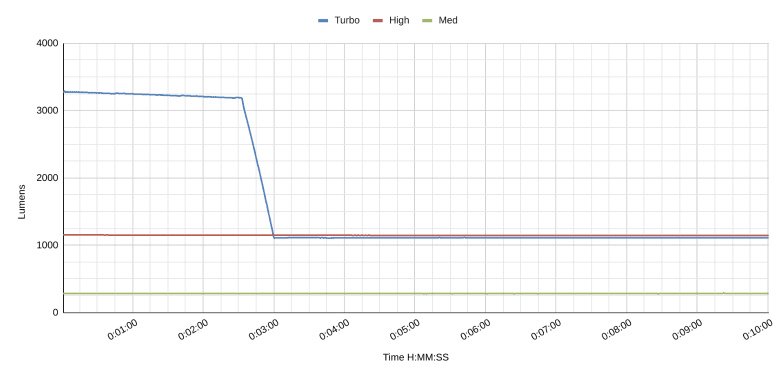
The Seeker 3 holds its 3000 or so lumens at turbo for 2.5 minutes before dropping over 30 seconds down to about 1100 lumens – the same as high. The Seeker 3 Pro for comparison gives you an extra 1000 lumens on turbo but holds them for a minute less before dropping to the same level.
The light lasted almost an hour and a half over 1000 lumens on turbo, which is impressive for its size. It then steps down to medium for a bit, then low, before the low voltage protection turns it off.
High follows turbo’s trend but lasts a few minutes longer at each level.
Medium lasts around 8 hours before stepping down.
Throw numbers:
Throw was measured indoors at 5m with a UNI-T UT383S lux meter.
| Mode | Specs | Candela measured | Meters | Yards |
|---|---|---|---|---|
| Low | – | 166 | 26 | 28 |
| Medium | – | 1221 | 70 | 76 |
| High | – | 5093 | 143 | 156 |
| Turbo | 12,100 cd / 220m | 14,657 cd | 242 | 265 |
Beamshots
Photos were taken with a Pixel 3a, set to 1/3s shutter speed and ISO 400, F1.8. White balance was locked on cool white.
Distance to the bench is 6m, the tree on the right is 13m, the tree on the center-right is 18m and the building behind it is 69m.
- Emisar D4V2
- Manker MC13 SBT90.2
- Cyansky P25
- Sofirn SD05
- Olight Seeker 3
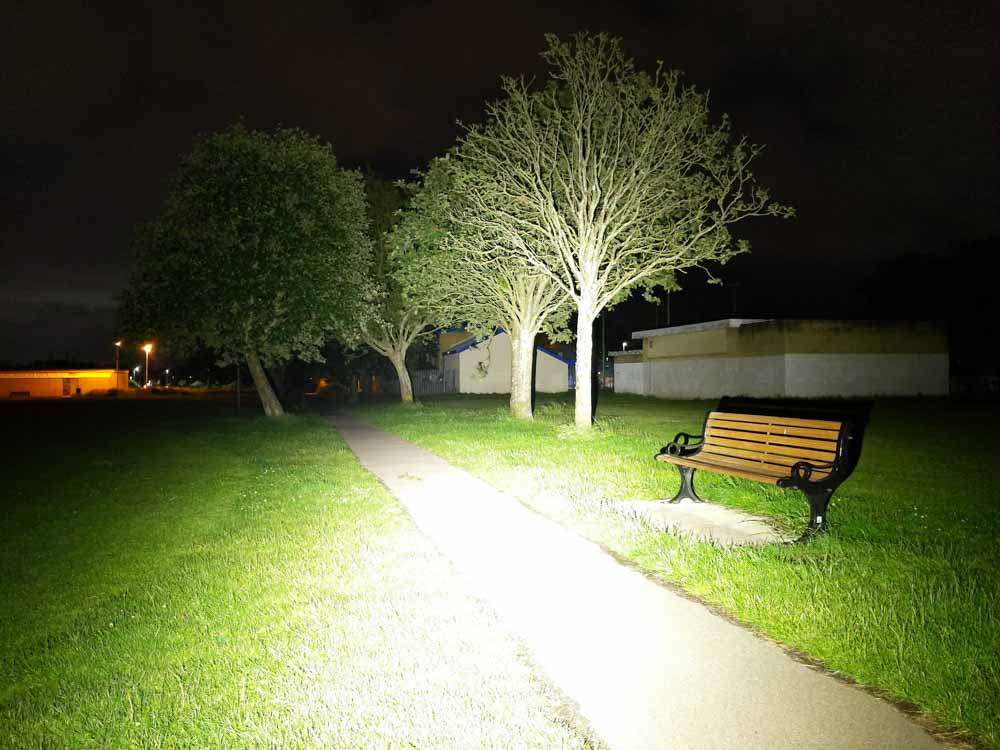
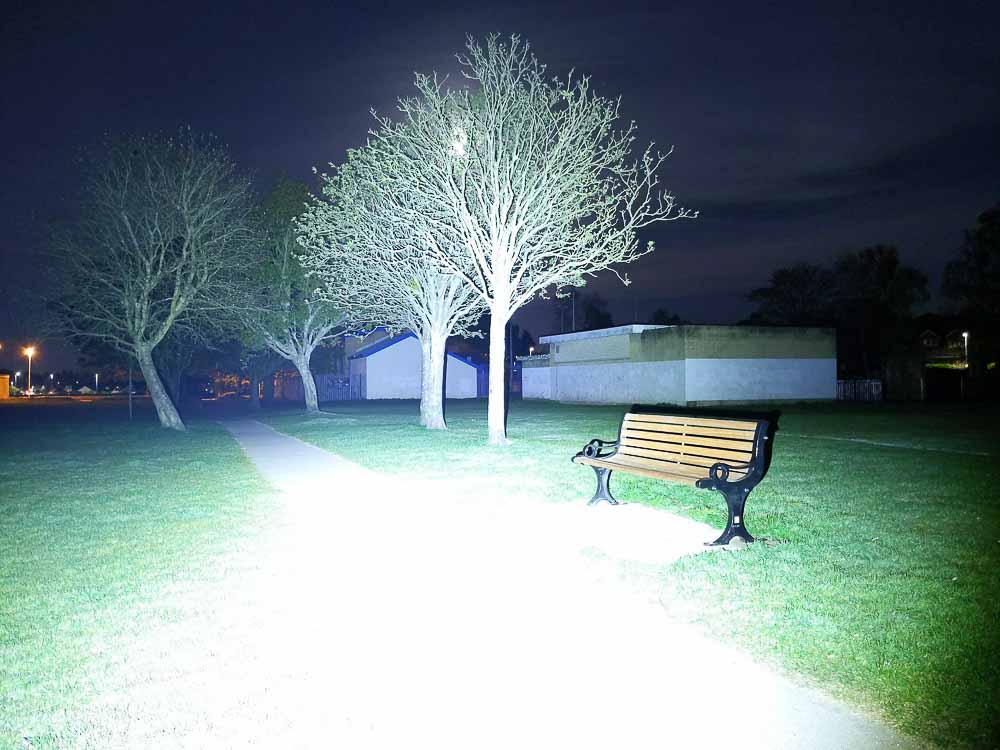
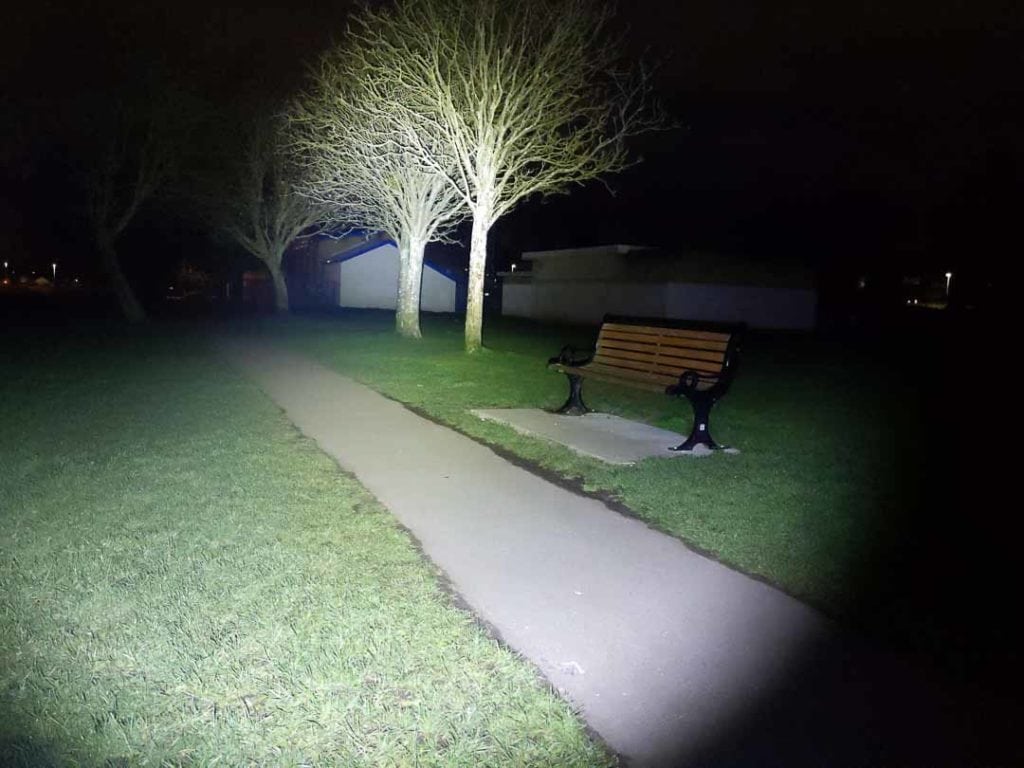
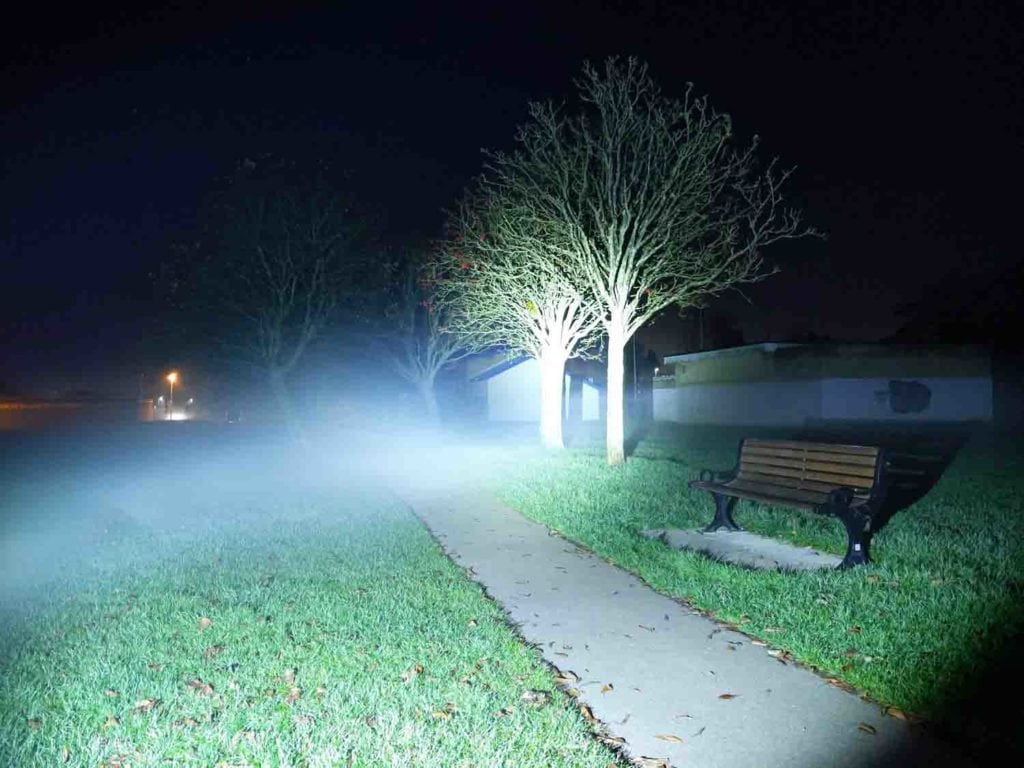
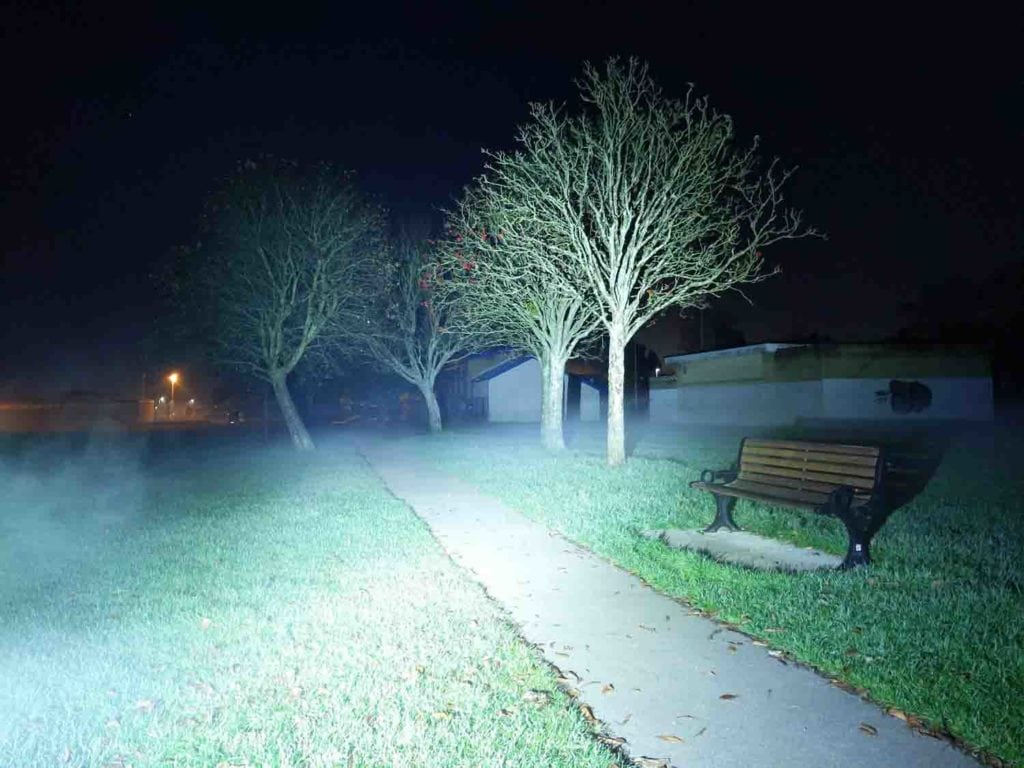
Disclaimer: This flashlight was sent to me for review at no cost by Olight. I have not been paid to review, nor have I been holding back on problems or defects.
Final Verdict
Pros
- Olight quality
- Light comes with cell and charger, all in a very fancy box
- Excellent sustained lumens
Cons
- No pocket clip
- Can’t use standard cells
- Cool white LED
Explanation on star ratings:
1: Avoid: my phone flashlight would be a better choice – 2: Poor: significant defect or issues, much better options available at the same price – 3: Average: some defects or issues – 4: Good: recommended (minor issues) – 5: Great: highly recommended

4.5 stars: ★★★★⋆
I don’t think this will be my last Olight. The Seeker 3 is lovely – Olight’s quality is possibly the best I’ve seen in a flashlight. The shape is also very nice to hold – almost organic. The output is great too – the regulated output is leaps and bounds above what you get with the FET+1 drivers you often see from Sofirn, Emisar, and Lumintop.
In terms of the other Seekers, the Seeker 3 is about 75% of the price of the Seeker 3 Pro and gives you about 75% of the features, missing out on the rotary switch, better output (for a minute) and cell capacity. If you can afford it then the Pro is the better choice. That’s not to say that the 3 is bad, just that if you’re getting a high end EDC flashlight, you may as well get the best you can get from Olight.
If you already have a Seeker 2 then upgrading to the 3 gives a handful more lumens and faster charging. The extra LED might make the Seeker 3 more efficient (sustaining higher output) but the provided cell is 4000mAh instead of the 5000mAh you get with the Seeker 2, so runtimes aren’t quite as long. The Seeker 3 feels like more of a refresh than a significant upgrade.
The lack of clip is very noticeable when I was EDCing the Seeker 3. If you always have clips on your lights then the Seeker 3 might not be for you, though I expect the clip you can buy for the Seeker 2 will fit the 3 fine.
Although the quality is great, you do get the standard Olight proprietary cell and cool white LEDs. Some people will love these, whilst others will hate them with a passion. Personally, I’m OK with the proprietary cell – I’d rather I could use any cell but it’s not a big problem for me. The colour temperature isn’t as bad as I was expecting and although I love high CRI warm LEDs, whatever LEDs Olight has used are more than reasonable.
Like Apple, if you buy into their ecosystem, you end up with some really nice hardware (and loads of cables you can’t use elsewhere). Just don’t expect to jailbreak your Olight and install Anduril on it.
Conclusion: The Seeker 3 is lovely. It’s a different kind of enthusiast light to a Hanklight or Convoy and is very close to getting a 5 star rating.
Olight Seeker 3 discount coupon
Get 10% using our special 1Lumen coupon code: 1Lumen
1lumen selects and reviews products personally. We may earn affiliate commissions through our links, which help support our testing.